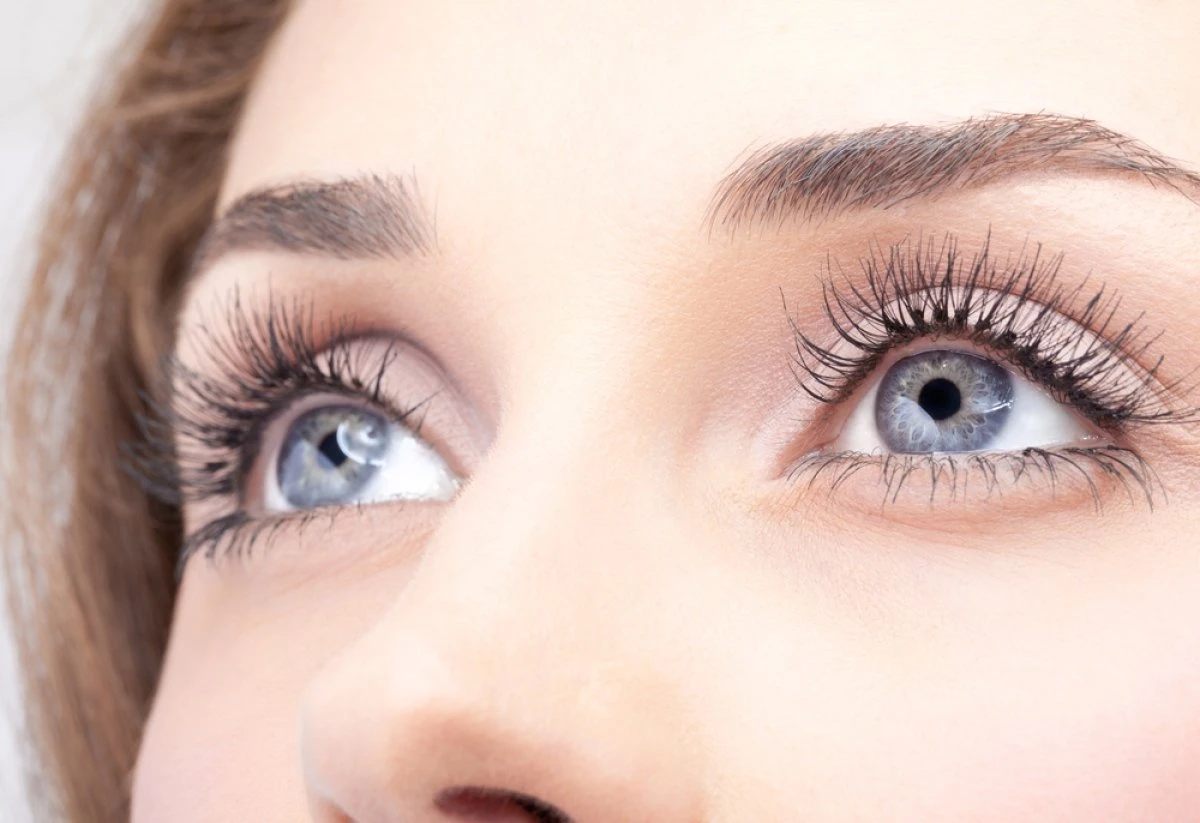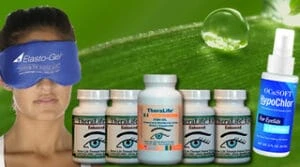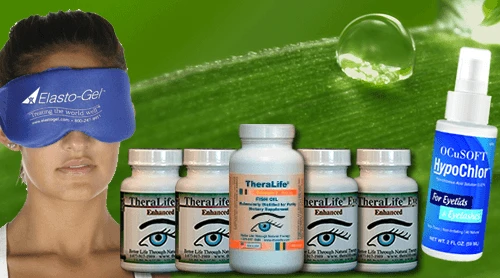Many people wake up with crusty eyes in the morning due to the natural collection of debris, shed epithelial cells, and mucus in the corners of their eyes during sleep. This process is a normal protective function that helps maintain eye health. However, when you experience thick, colored discharge or irritation, it may indicate an infection.
Theralife is a unique company that stands out by offering oral eye treatment care, something not provided by others. Their products are designed to enhance eye health by addressing the root causes of various eye conditions from within, offering a comprehensive approach to eye wellness.
Theralife’s products are especially beneficial for those suffering from conditions like blepharitis, dry eyes, or recurrent chalazions. They focus on restoring the natural balance of the eyes using oral supplements that support tear production and reduce inflammation. This approach not only alleviates symptoms but also promotes long-term eye health.
Unlike topical solutions, Theralife’s oral treatments work systemically, providing relief from symptoms such as crusty eyes and irritation. If you’re experiencing persistent eye issues, Theralife offers a holistic and unique solution tailored to improve your eye health from the inside out.
Get Rid Of Crusty Eyes – Treat Your Dry Eyes With TheraLife
Crusty Eyes Management with TheraLIfe All In One Dry Eye Starter Kit.
Add To Cart
Key Takeaways
- Eye crust forms overnight as a normal mix of mucus, oils, skin cells, and debris collected in the corners of your eyes.
- Tears and eyelid movements help flush out debris while you sleep, leading to crust formation as secretions dry.
- Allergies, environmental irritants, or dry air can increase eye discharge and make morning crust more noticeable.
- Excessive, thick, yellow, or green discharge could indicate an eye infection or inflammation requiring medical attention.
- Good eyelid hygiene and minimizing allergen exposure can help reduce morning eye crust and maintain eye health.
What Is Eye Discharge?
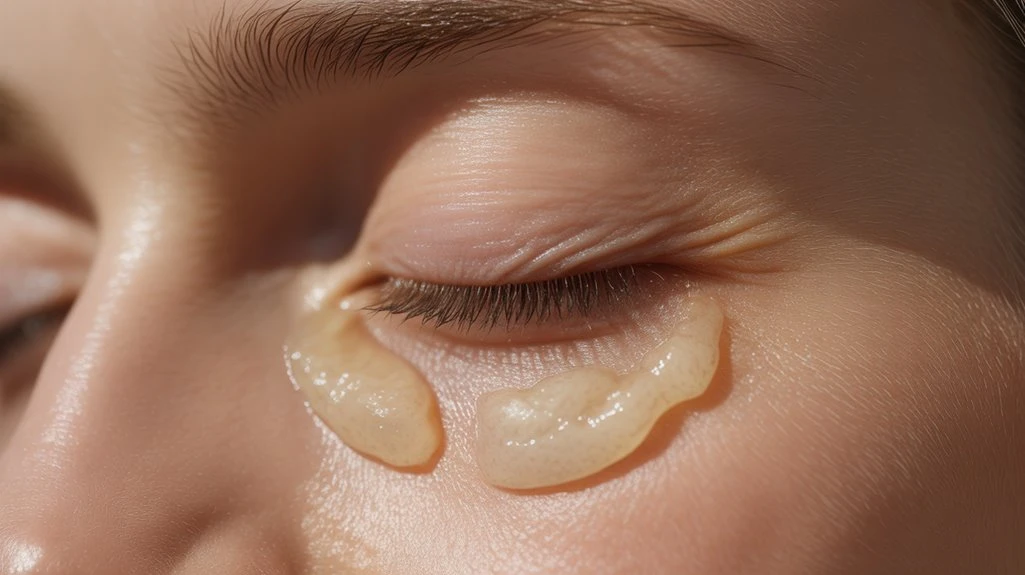
Eye discharge, also known as rheum, consists of a mixture of mucus, oil, skin cells, and other debris that accumulates in the corners of your eyes during sleep. This material is a byproduct of the normal protective mechanisms of the ocular surface. You’ll notice varying discharge types, ranging from thin and watery to thick and crusty, depending on underlying factors such as tear composition and ocular surface health. Maintaining proper eye hygiene is important, as inadequate cleaning can exacerbate buildup and increase the risk of irritation or infection. While a small amount of discharge upon waking is physiologically normal, significant changes in consistency, color, or volume may indicate infection or inflammation, warranting clinical evaluation. Recognizing discharge types supports effective eye hygiene and ocular health. Watery discharge is often linked to blocked tear ducts.
How Your Eyes Clean Themselves Overnight
During sleep, your ocular surface relies on several protective mechanisms to maintain health and clear debris.
You don’t blink while you’re asleep, so your eyes depend on continuous tear production and the action of the eyelids to facilitate nightly cleansing. Basal tears, produced by the lacrimal glands, form a thin film across the cornea, trapping particulates, cellular debris, and microorganisms.
This tear film gradually moves toward the inner corner of your eye, aided by subtle eyelid movements that occur during REM sleep. Simultaneously, specialized enzymes and proteins in tears, such as lysozyme and lactoferrin, break down bacteria and neutralize potential pathogens.
Overnight, these processes collectively help remove waste and maintain ocular surface integrity, resulting in the accumulation of dried tear film and debris by morning. Additionally, the Meibomian Glands produce an oily substance that mixes with tears, providing essential lubrication and protection for the eye.
Types of Eye Crust: What’s Normal?
Crust formation at the eyelid margins—commonly known as “sleep” or rheum—is a routine physiological occurrence.
Overnight, your eyes secrete a mixture of mucus, exfoliated epithelial cells, meibomian gland lipids, and minor environmental debris. This material accumulates at the canthi (corners) of your eyes as a thin, pale, slightly sticky deposit.
Normal rheum is scant, easily removed, and doesn’t cause eyelid adhesion or discomfort. Its presence often indicates effective eye hygiene and a healthy tear film, both of which contribute to ideal sleep quality by protecting the ocular surface during eyelid closure.
If you maintain good eye hygiene and experience typical amounts of clear, non-irritating crust, there’s usually no cause for concern. Significant deviation from this norm may warrant further evaluation. However, if you notice increased eye crust, it may signal underlying issues that require a consultation with an eye doctor.
Common Causes of Morning Eye Crust
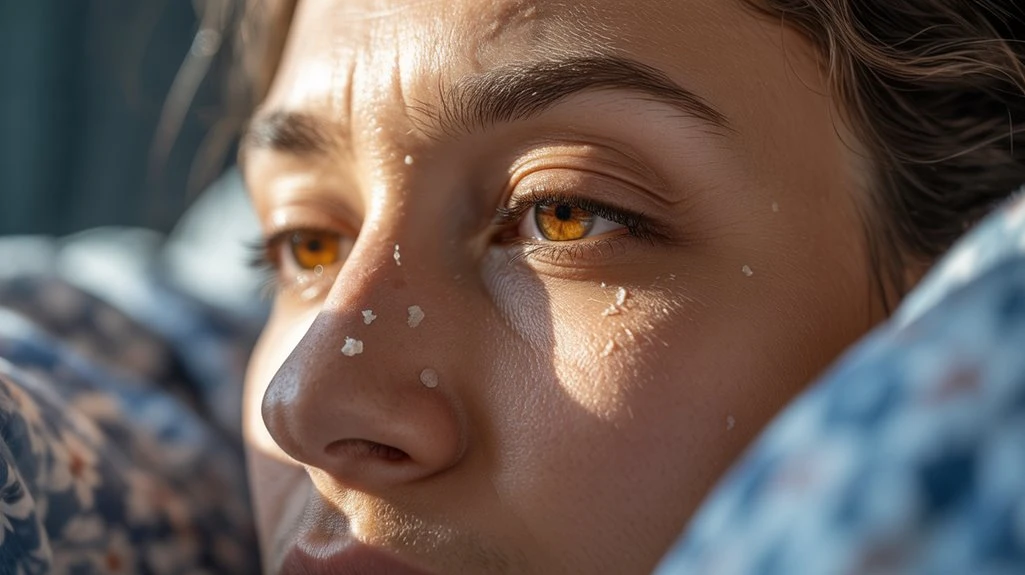
You’ll notice morning eye crust due to the overnight accumulation of tear film debris and epithelial cells. Allergic reactions and exposure to environmental irritants can also increase mucous production, contributing to this discharge. Recognizing these mechanisms helps you distinguish between physiological and pathological causes of eye crust. Proper eye hygiene plays a crucial role in managing and preventing excessive buildup of crusty eyes in the morning.
Natural Tear Film Process
A well-functioning tear film plays an essential role in maintaining ocular surface health, and its natural overnight dynamics often contribute to the formation of morning eye crust.
When you sleep, your tear film—composed of lipid, aqueous, and mucin layers—continues to protect and lubricate your eyes, but tear production decreases. This reduction in eye lubrication, combined with minimal blinking, allows debris and shed epithelial cells to accumulate at the eyelid margins.
The meibomian glands also secrete lipids that can mix with this debris, forming a crust as the aqueous component evaporates. Upon waking, you may notice this residue at the corners of your eyes.
This crust is typically benign and reflects the normal physiological processes regulating tear film and ocular surface maintenance overnight.
Allergies and Irritants
In addition to normal tear film dynamics, exposure to allergens and environmental irritants frequently contributes to excessive morning eye crust. When your eyes encounter environmental triggers—such as pollen, dust mites, or pet dander—your immune system may initiate allergic reactions. These responses increase conjunctival inflammation and stimulate mucous and serous glandular secretions overnight. Inflammatory cytokines such as IL-1beta, TNF-alpha, and IL-8 are induced by hyperosmolar stress, leading to increased conjunctival inflammation and irritation.
Here’s a comparison of common environmental triggers and their effects:
| Environmental Trigger | Clinical Effect on Eyes |
|---|---|
| Pollen | Itching, excessive mucus |
| Dust mites | Redness, lid swelling |
| Pet dander | Watery discharge, crust |
| Smoke/chemicals | Irritation, burning |
Allergic conjunctivitis often results in mucopurulent discharge that accumulates during sleep. If you frequently notice thick, sticky crusts upon waking, you should evaluate your exposure to potential allergens and discuss symptomatic management with an eye care professional.
Allergies and Their Role in Eye Discharge
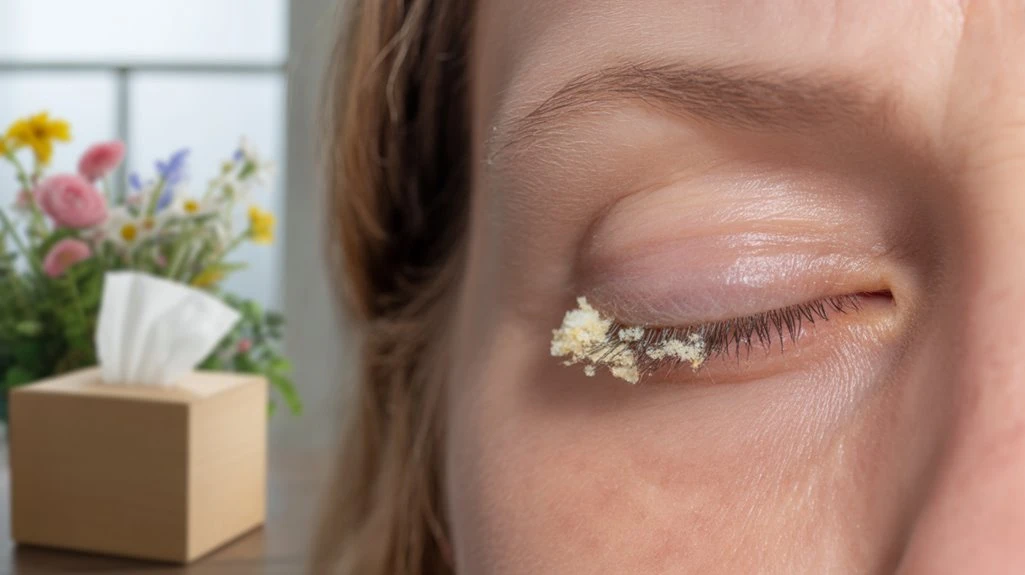
Although many individuals attribute morning eye crust to allergies, current clinical evidence doesn’t support a direct causal relationship between allergic reactions and the production of significant overnight eye discharge.
When you’re exposed to environmental triggers such as pollen, dust mites, or pet dander, your immune system may mount an allergic response, resulting in ocular symptoms like itching, redness, and mild watery discharge.
However, this allergic conjunctival response typically produces clear, watery secretions rather than the thicker, crusty residue observed upon waking.
While allergic reactions can exacerbate general ocular discomfort and increase mucus production, the formation of substantial crust—particularly overnight—remains unsubstantiated in allergy-related conditions.
It is important to note that allergies can indeed increase mucus production, which might worsen the crust formation, even if they are not the direct cause.
Consequently, if you notice persistent or excessive morning eye crust, it’s important to examine other etiologies beyond allergy-mediated mechanisms.
When Crusty Eyes Signal an Infection
You should recognize that persistent, thick, yellow or green discharge, conjunctival injection, and eyelid edema often indicate an underlying eye infection. If you develop symptoms such as ocular pain, photophobia, or visual disturbance, it’s important to seek prompt medical evaluation. Early intervention reduces the risk of complications and transmission. Contact lens-related infections can result in thick eye discharge and should be evaluated by an eye care professional.
Signs of Eye Infection
Occasionally, crusty eyes upon waking may indicate an underlying eye infection rather than a benign accumulation of dried tears or debris. Infection symptoms often include persistent yellow or green discharge, pronounced conjunctival redness, eyelid swelling, and discomfort such as burning, itching, or pain. You might also notice increased tearing and blurred vision. These manifestations suggest bacterial or viral conjunctivitis, blepharitis, or other infectious etiologies. Practicing proper eye hygiene—such as avoiding touching your eyes with unwashed hands and refraining from sharing towels—can reduce the risk of infection. It’s important to distinguish normal morning crust from signs of pathology; crust associated with infection tends to be more abundant, sticky, and recurrent. If you observe symptoms like large amounts of discharge and difficulty opening your eyes, it may be time to seek medical attention. Recognize these clinical features to guarantee early identification and prevention of further ocular complications.
When to Seek Care
When should crusty eyes prompt medical evaluation? While mild morning discharge is common, certain symptoms indicate a possible infection or underlying disorder related to the causes of crustiness. If you notice persistent redness, pain, or vision changes, seek prompt ophthalmic assessment.
Evidence-based guidelines emphasize medical attention if crustiness is accompanied by:
- Thick yellow or green discharge that persists despite proper eye hygiene practices.
- Significant eyelid swelling or difficulty opening your eyes, which may suggest severe conjunctivitis or blepharitis.
- Sensitivity to light or sudden decrease in vision, signaling potential keratitis or more serious pathology.
Inadequate eyelid and lash hygiene can lead to infections like styes, which may contribute to morning crustiness.
Timely intervention prevents complications and transmission, especially if symptoms worsen or affect both eyes.
Maintaining rigorous eye hygiene practices can reduce infection risk, but medical evaluation is essential when these warning signs appear.
Other Medical Conditions Linked to Eye Crust
Although eye crusting most commonly results from benign causes such as normal overnight tear film debris, several underlying medical conditions can also contribute to its formation.
If you experience persistent or excessive eye discharge, you should consider possible pathologies like conjunctivitis or blepharitis. Conjunctivitis symptoms typically include redness, irritation, and purulent or watery discharge, which can lead to significant morning crusting.
In contrast, blepharitis manifests with chronic eyelid inflammation, meibomian gland dysfunction, and debris accumulation along the lash line. Effective blepharitis treatment involves eyelid hygiene, topical antibiotics, or anti-inflammatory agents tailored to the underlying etiology.
Less commonly, systemic conditions such as dacryocystitis or ocular allergies may increase eye crusting. Recognizing these associations guarantees prompt diagnosis and targeted management for peak ocular surface health.
Tips to Prevent Excessive Eye Crusting
Understanding the potential medical causes of eye crusting highlights the importance of preventive strategies to maintain ocular surface integrity.
To reduce excessive eye crusting, you should focus on meticulous eye hygiene and optimize your sleep position. Evidence indicates that accumulation of debris and bacteria at the eyelid margin can exacerbate crusting, while certain sleep positions may increase tear film evaporation.
Consider these evidence-based interventions:
- Practice daily eyelid cleansing: Use a sterile, hypoallergenic cleanser to remove debris and reduce microbial load.
- Adjust your sleep position: Elevate your head or avoid sleeping face-down to minimize ocular surface exposure and fluid accumulation.
- Maintain a clean sleep environment: Change pillowcases regularly and minimize exposure to allergens to reduce inflammatory triggers.
Implementing these steps can help support ocular health and reduce morning eye crusting.
When to Seek Medical Help for Eye Discharge
Occasionally, eye discharge signals an underlying condition that warrants prompt evaluation by an ophthalmologist. If you notice persistent redness, pain, photophobia, blurred vision, or copious purulent discharge, seek medical attention immediately. These symptoms may indicate conjunctivitis, keratitis, or nasolacrimal duct obstruction, each requiring specific treatment options. Adhering to proper eye hygiene—such as avoiding contact with contaminated hands and regularly cleaning eyelids—helps prevent secondary infections but doesn’t replace medical evaluation for severe symptoms. Early intervention optimizes outcomes and reduces risk of complications.
| Symptom | Possible Cause |
|---|---|
| Persistent redness | Conjunctivitis |
| Severe pain | Corneal ulcer |
| Photophobia | Uveitis |
| Blurred vision | Keratitis |
| Thick yellow discharge | Bacterial infection |
Consult a specialist if these symptoms persist despite good eye hygiene.
Get Rid Of Crusty Eyes – Treat Your Dry Eyes With TheraLife
Crusty Eyes Management with TheraLIfe All In One Dry Eye Starter Kit.
Add To Cart
Frequently Asked Questions
Can Certain Foods Increase Eye Discharge or Crusting?
Certain foods can influence eye discharge through dietary impacts, particularly if you have food allergies.
When you consume allergenic foods, your immune system may trigger an inflammatory response, leading to increased mucus production and ocular surface irritation.
Clinical evidence shows that common allergens, such as dairy or gluten, may exacerbate symptoms in sensitive individuals.
If you notice increased crusting, consider discussing potential food allergies with a healthcare professional for targeted management.
Is Morning Eye Crust Different for Contact Lens Wearers?
If you wear contact lenses, you may notice morning eye crust differs from non-wearers due to contact lens hygiene and eye irritation causes.
Poor lens hygiene can introduce microorganisms, increasing risk of conjunctivitis and mucous discharge.
Additionally, contact lenses may disrupt the tear film, leading to increased debris accumulation overnight.
Clinical evidence shows that lens wearers with suboptimal hygiene or extended wear schedules have a higher incidence of morning eye discharge and crusting.
Does Sleeping Position Affect Eye Discharge Amount?
Imagine you wake up, and depending on your sleeping habits, you notice more or less ocular discharge.
Could your position really influence eye hygiene overnight? Clinically, yes—when you sleep on your side or face-down, gravity may impede normal tear drainage, causing increased accumulation of rheum.
Evidence suggests supine positioning allows more effective tear flow and drainage, potentially reducing conjunctival secretions and periocular crust formation by morning.
Your habits truly shape your eye’s environment.
Can Pets Transmit Eye Infections Causing Crusty Eyes?
You should know that pets can transmit eye infections, particularly if pet hygiene isn’t maintained.
Pathogens like bacteria or viruses may transfer from your pet’s fur, saliva, or ocular secretions to your eyes, facilitating infection transmission.
Direct contact or contaminated hands increase this risk.
Evidence shows zoonotic agents such as Staphylococcus or Chlamydia species can cause conjunctivitis, leading to symptoms like crusty eyes.
Practicing strict pet hygiene reduces infection transmission likelihood.
Are There Home Remedies to Remove Eye Crust Safely?
You can employ natural treatments and gentle cleansing to safely remove eye crust.
Use sterile saline solution or lukewarm water with a clean, lint-free cloth to gently cleanse the eyelid margins.
Avoid harsh chemicals or vigorous scrubbing, as these may disrupt the ocular surface or exacerbate irritation.
Evidence supports regular eyelid hygiene as an effective, non-pharmacologic approach for managing mild crusting.
If symptoms persist or worsen, consult an ophthalmologist promptly.
Get Rid Of Crusty Eyes – Treat Your Dry Eyes With TheraLife
Crusty Eyes Management with TheraLIfe All In One Dry Eye Starter Kit.
Add To Cart
Conclusion
Waking up with crusty eyes is typically your body’s natural process of eliminating debris to maintain ocular health. However, if you’ve been experiencing persistent, colored, or excessive crusting, this could indicate infections, allergies, or other underlying conditions. At TheraLife, we understand the importance of effective eye care and offer unique oral treatment solutions that support your eye’s natural defenses.
TheraLife is the only company providing oral treatment specifically designed to alleviate eye discomfort, ensuring comprehensive relief from various eye conditions like blepharitis, dry eyes, and more. Our products are crafted to optimize eye health by addressing the root causes internally, rather than just providing temporary relief.
By monitoring your symptoms and integrating TheraLife’s innovative oral treatment into your routine, you’ll not only enhance your eye health but also gain peace of mind. For concerns beyond typical symptoms, consulting a healthcare professional is always advisable. Discover the difference with TheraLife and support your eyes with the care they deserve.
References
- 1.
- Shekhawat NS, Shtein RM, Blachley TS, Stein JD. Antibiotic Prescription Fills for Acute Conjunctivitis among Enrollees in a Large United States Managed Care Network. Ophthalmology. 2017 Aug;124(8):1099-1107. [PMC free article] [PubMed]
- 2.
- Smith AF, Waycaster C. Estimate of the direct and indirect annual cost of bacterial conjunctivitis in the United States. BMC Ophthalmol. 2009 Nov 25;9:13. [PMC free article] [PubMed]
- 3.
- 4.
- de Laet C, Dionisi-Vici C, Leonard JV, McKiernan P, Mitchell G, Monti L, de Baulny HO, Pintos-Morell G, Spiekerkötter U. Recommendations for the management of tyrosinaemia type 1. Orphanet J Rare Dis. 2013 Jan 11;8:8. [PMC free article] [PubMed]
- 5.
- Sati A, Sangwan VS, Basu S. Porphyria: varied ocular manifestations and management. BMJ Case Rep. 2013 May 22;2013 [PMC free article] [PubMed]
- 6.
- Azari AA, Barney NP. Conjunctivitis: a systematic review of diagnosis and treatment. JAMA. 2013 Oct 23;310(16):1721-9. [PMC free article] [PubMed]
- 7.
- 8.
- Shields T, Sloane PD. A comparison of eye problems in primary care and ophthalmology practices. Fam Med. 1991 Sep-Oct;23(7):544-6. [PubMed]
- 9.
- 10.
- Turaka K, Penne RB, Rapuano CJ, Ayres BD, Abazari A, Eagle RC, Hammersmith KM. Giant fornix syndrome: a case series. Ophthalmic Plast Reconstr Surg. 2012 Jan-Feb;28(1):4-6. [PubMed]
- 11.
- Satpathy G, Behera HS, Ahmed NH. Chlamydial eye infections: Current perspectives. Indian J Ophthalmol. 2017 Feb;65(2):97-102. [PMC free article] [PubMed]
- 12.
- Bhosai SJ, Bailey RL, Gaynor BD, Lietman TM. Trachoma: an update on prevention, diagnosis, and treatment. Curr Opin Ophthalmol. 2012 Jul;23(4):288-95. [PMC free article] [PubMed]
- 13.
- 14.
- Makker K, Nassar GN, Kaufman EJ. StatPearls [Internet]. StatPearls Publishing; Treasure Island (FL): Jul 17, 2023. Neonatal Conjunctivitis. [PubMed]
- 15.
- Hoffman J. Adenovirus: ocular manifestations. Community Eye Health. 2020;33(108):73-75. [PMC free article] [PubMed]
- 16.
- Giladi N, Herman J. Pharyngoconjunctival fever. Arch Dis Child. 1984 Dec;59(12):1182-3. [PMC free article] [PubMed]
- 17.
- Meyer-Rüsenberg B, Loderstädt U, Richard G, Kaulfers PM, Gesser C. Epidemic keratoconjunctivitis: the current situation and recommendations for prevention and treatment. Dtsch Arztebl Int. 2011 Jul;108(27):475-80. [PMC free article] [PubMed]
- 18.
- Wright PW, Strauss GH, Langford MP. Acute hemorrhagic conjunctivitis. Am Fam Physician. 1992 Jan;45(1):173-8. [PubMed]
- 19.
- Saleh D, Yarrarapu SNS, Sharma S. StatPearls [Internet]. StatPearls Publishing; Treasure Island (FL): Aug 28, 2023. Herpes Simplex Type 1. [PubMed]
- 20.
- Yoser SL, Forster DJ, Rao NA. Systemic viral infections and their retinal and choroidal manifestations. Surv Ophthalmol. 1993 Mar-Apr;37(5):313-52. [PubMed]

